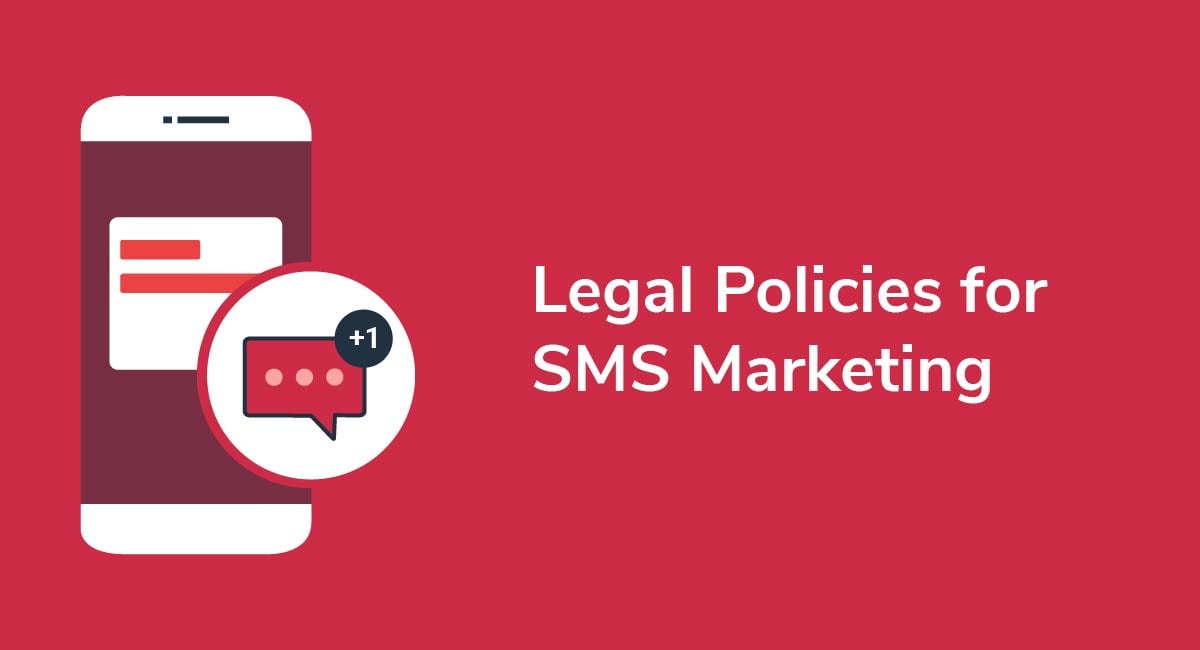Terms and Conditions for Digital Products and Purchases
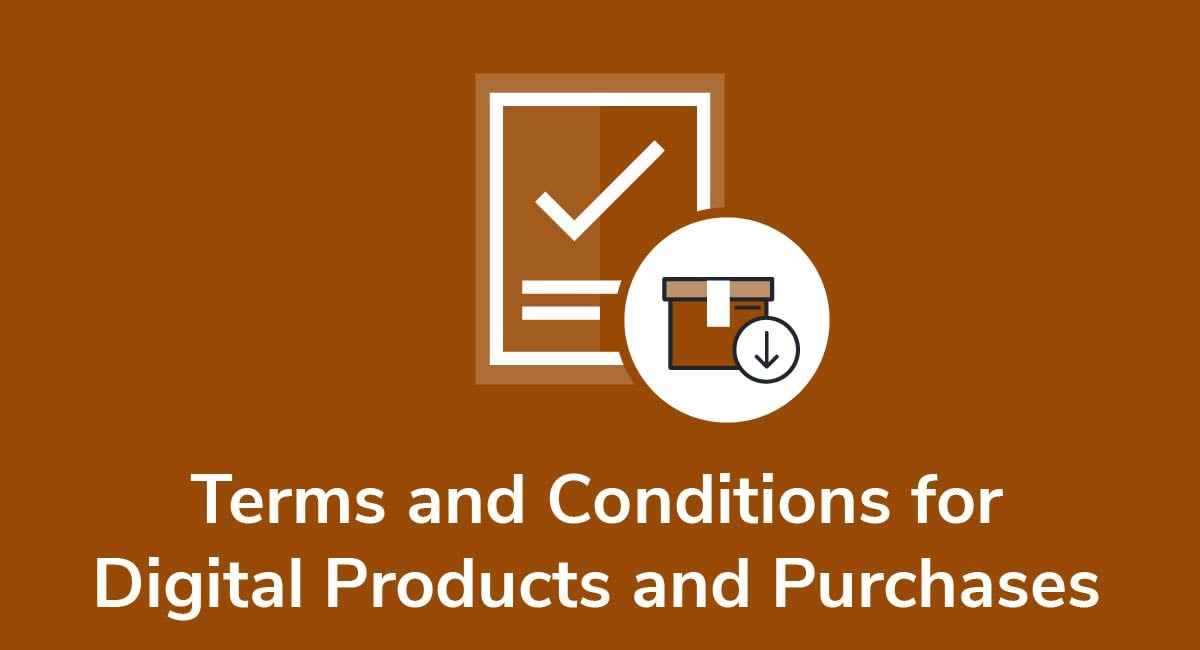
There are lots of benefits to selling digital products instead of traditional tangible goods. However, the digital product business model has a number of nuances that should be addressed in your Terms and Conditions agreement (T&C).
In this article, we'll explain why you need a T&C for your digital products and help you create a thorough, well-written, and legally enforceable Terms and Conditions agreement for your own business.
Need Terms and Conditions for your business? We can help you generate a customized Terms and Conditions agreement in around two-three minutes for free. Try our Terms and Conditions Generator and just follow these steps:
- Click on the "Create your Terms and Conditions today" button.
- At Step 1, select the where will you use your Terms & Conditions and click "Next step":
- Add information about your business:
- Select the country and continue to the "Next step":
- Answer the questions about your business practices and click "Next step" when finished:
-
Enter your email address where you'd like your agreement sent and click "Generate."

You're done! Now you'll be able to instantly access and download your new agreement.



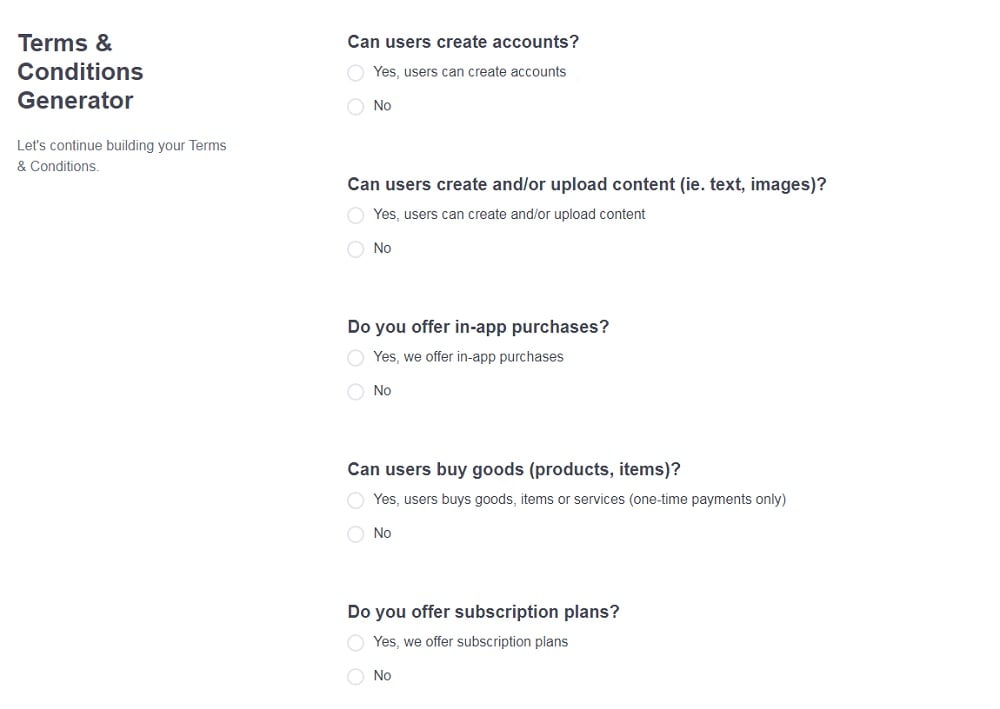
- 1. What are Terms and Conditions Agreements?
- 2. What are Digital Products?
- 3. Are Terms and Conditions Legally Required for Digital Products and Purchases?
- 4. What Information Should You Include in Terms and Conditions for Digital Products?
- 4.1. Introduction/Overview
- 4.2. Licensing
- 4.3. Refunds and Returns
- 4.4. Warranty/Disclaimer of Warranty
- 4.5. Delivery
- 4.6. Quality of Display
- 4.7. Membership
- 4.8. Removal of Digital Content
- 4.9. Copyright
- 5. Where Should You Display Terms and Conditions for Digital Products?
- 5.1. Within Website Footers
- 5.2. Linked to in Privacy Policies and Other Legal Documents
- 5.3. At Sign-Up, Registration and Log-In
- 5.4. In Mobile App Menus
- 6. How Do You Get Users to Consent to Your Terms and Conditions for Digital Products?
- 7. Summary
What are Terms and Conditions Agreements?
In a nutshell, Terms and Conditions agreements (also referred to as Terms of Use agreements) are documents that set out the rules and restrictions that govern the relationship between you and your customers/end users.
Your Terms and Condition agreement should address the specifics of your individual business as well as any other particulars that apply to digital products and purchases in general.
Some types of clauses and information covered include:
- Licensing rights and restrictions
- How refunds are handled
- Any warranties granted or disclaimed
- Limitations on your legal liability
At the end of the day, having a rock-solid Terms and Conditions agreement will limit your liability and let customers know what to expect during your business relationship.
What are Digital Products?

Digital products are any non-physical goods that are only available in digital or electronic form.
Digital products include everything from ebooks and online courses to music downloads and Software as a Service (SaaS).
These days, digital products are becoming increasingly popular with customers because they're usually available via download or email link immediately after a purchase is made.
In addition, digital products don't take up desk, closet, or cabinet space because they're stored electronically on servers, phones, laptops and desktop computers.
Likewise, more and more business owners are turning to digital products because they offer a number of advantages compared to tangible goods.
Here are a few reasons why selling digital products makes good business sense:
- No warehousing, transportation or distribution costs
- Easy instant delivery via download or email
- Lower overall cost
- Digital products can be updated electronically
- Business owners can restrict access to digital products if customers fail to comply with Terms and Conditions
Are Terms and Conditions Legally Required for Digital Products and Purchases?

Terms and Conditions aren't legally required if you sell digital products.
However, it's incredibly important to have one even though it is not a legal requirement. This is because they allow business owners to establish the ground rules that apply when customers purchase and use their digital products.
As a business owner, your Terms and Conditions agreement can minimize risk, limit liability and bolster your company's professional image, but there are a number of benefits for customers as well.
Your Terms and Conditions agreement can provide customers with much-needed clarity and transparency. In addition, prospective customers are more likely to purchase a digital product from you if they know what's expected of them and what they can expect from you every step along the way.
A clear and well-written Terms and Conditions agreement can also give savvy shoppers peace of mind that they're not dealing with a fly-by-night company.
What Information Should You Include in Terms and Conditions for Digital Products?

Your Terms and Conditions agreement should address the nuances of your individual business as well as those that apply to the digital products business model in general.
No two Terms and Conditions agreements for digital products are exactly alike. After all, there are numerous differences between selling children's ebooks to parents who homeschool their children and selling complicated accounting software to large multinational firms.
In this section, we'll look at a number of examples of clauses that should be included in your Terms and Conditions agreements for digital products and purchases.
Introduction/Overview
Many Terms and Conditions agreements for both tangible and digital products begin with an introduction or overview that typically include some or all of the following:
- When the agreement was last updated
- Which parties are subject to the agreement's terms
- What products and services your company provides
- Any other relevant information that may not be addressed elsewhere
In this example, PublishDrive provides this information as it relates to digital products like ebooks, audiobooks, and other digital content:

Licensing
Digital products are often licensed, such as in the case of downloading a mobile app. Your Terms and Conditions agreement can be used to let users know this, and what kind of license they are getting from you.
Here's an example of a clause that addresses licenses:

Refunds and Returns
Many companies sell both tangible and digital products. However, refund and return policies often vary greatly from one product type to the next.
Most tangible products can be returned for any number of reasons, but there are usually more restrictions, limitations, and prohibitions when it comes to returning digital products and requesting refunds.
Either way, it's important to make a clear distinction between the two if you sell both types of products.
In the following example, Western Digital addresses both digital and tangible products:

Western Digital makes it clear that devices (tangible goods) may be returned, but that this doesn't apply to software (digital products) that's been delivered via download, link, license key, email, or any other electronic method.
Warranty/Disclaimer of Warranty
Disclaimers of warranty help to limit your liability when the goods you sell are defective or just don't meet the customer's expectations.
Many physical goods come with some type of warranty, but this isn't necessarily true with digital products.
Either way, you should include a disclaimer of warranty in your Terms and Conditions agreement whether you sell tangible products, digital products, or both.
Here's another example from Western Digital:

Because Western Digital sells various devices and digital software, a clear distinction is made between the two (in regard to warranty) in the opening paragraph.
Delivery
Unlike tangible goods that are often shipped from another state or country, digital products aren't delivered by a truck, rail, or air. Instead, buyers can usually access their digital product via link or download immediately after making an online purchase.
In the following example, Western Digital lets customers know that it will arrange transportation for physical goods, but that software is generally delivered electronically via download or digital transmission:

Quality of Display
Quality of display is one potential issue that only applies to digital products and not tangible goods.For example, when Netflix subscribers watch movies online, video quality can be affected by a number of factors outside the company's control.
These can include things like location, available bandwidth, internet speed, and the quality and operability of equipment owned by the customer.
Customers with slow internet and old, low-end, or damaged computers generally experience slower-than-normal video speeds and poorer image quality than customers with lightning fast internet and brand new high-end computers.
Obviously, these variables just don't apply when a customer orders a tangible product like a paperback book from a retailer like Amazon.
Here's how Netflix address display quality in its Terms of Use agreement:

Membership
Membership terms often vary between digital products and tangible products, even when they're sold by the same company.
In the following example, Netflix's membership clause states that users must have internet access, a Netflix ready device, and provide the company with at least one approved payment method before using the service:

Again, there's a clear distinction to be made here because customers don't generally need an internet connection or specific electronic devices to use tangible products.
Removal of Digital Content
Many digital content and digital service providers also allow customers to post their own digital content to websites and other platforms.
When the exchange of digital content goes both ways, your Terms and Conditions should spell out what rules and restrictions apply and what actions you'll take if posters don't abide by the terms of your agreement.
In this example, PublishDrive asserts its right to remove posted digital content from its website at any time, for any reason, or for no reason at all:

It also lists a number of specific offenses that may result in digital content being taken down.
Copyright
Digital products are especially susceptible to copyright infringement and other abuses. Needless to say, it's worth addressing in your Terms and Conditions agreement.
In the following example, online course provider Coursera addresses this in its Terms of Use:

Where Should You Display Terms and Conditions for Digital Products?

There are a number of areas where you can place Terms and Conditions for digital products to make sure customers can find them easily.
Within your website's footer is the most popular location. Terms and Conditions can also be linked to in your Privacy Policy, at log in and account registration, on individual product pages, and at checkout to name just a few.
Now let's look at a few examples.
Within Website Footers
You'll want to place a link to your Terms and Conditions within the footer of your website. Users know to look here, and it's a very conspicuous place, available from every page of your site.
Here's how Netflix links to its Terms of Use at the bottom (footer) of its site:

In the following example, Stanford University provides a link to its Terms of Use in the site footer:

Linked to in Privacy Policies and Other Legal Documents
Linking your Terms and Conditions agreement within your Privacy Policy helps users find it when they're checking out your important legal documents and information.
Here's how edX provides a link to its Terms of Service in its Privacy Policy:

At Sign-Up, Registration and Log-In
Many companies that sell digital products provide links to their Terms and Conditions when new customers create an account and when existing customers log in.
In this example, edX, places links to its Terms of Service at its new customer registration form:

In Mobile App Menus
If your site has a mobile app component, you can link to your Terms agreement within a menu. Standard places are a "Settings" or "Legal" or "About" menu, like here:
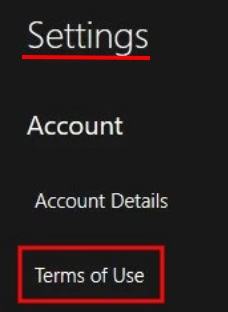
How Do You Get Users to Consent to Your Terms and Conditions for Digital Products?

Without consent, your Terms and Conditions will not be legally enforceable. The most legally compliant, fail-proof method of obtaining consent is to use I Agree checkboxes. This is where you ask a user to check a box next to a statement showing that they are consenting to be bound by your Terms.
Here's an example:

Here's an example of how this can be done on a mobile app as well, from FITTR:
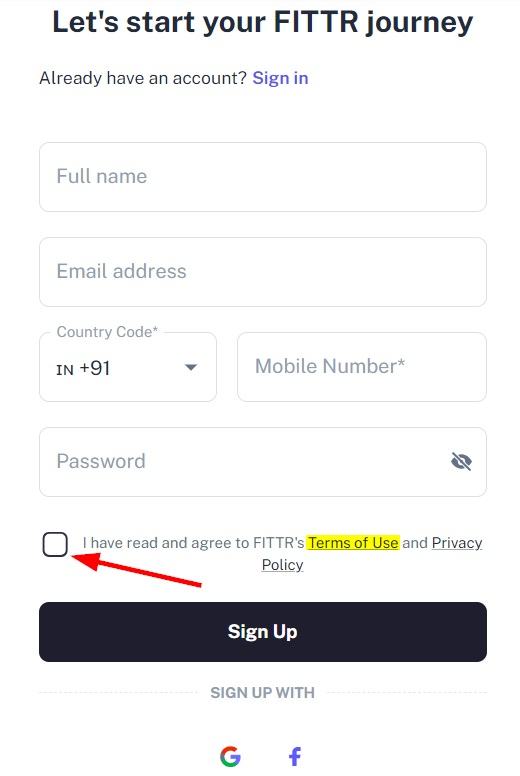
And here's another example from Fitness Blender:

Summary
To recap, digital products are any non-physical goods that are only available in digital or electronic form. If you sell digital products, your Terms and Conditions agreement is where you'll lay out the restrictions and ground rules that apply when customers make a purchase and use your products.
You aren't legally required to have Terms and Conditions for digital products. However, most companies that sell digital products have Terms and Conditions agreements because they offer a number of benefits and protections for business owners and customers alike.
Even though Terms and Conditions aren't legally required, they are legally binding agreements. As such, they should be thorough, well-written, and relatively easy for customers to find and understand.
Include clauses that address things like warranties, copyright, licenses, and refunds.
Display your agreement conspicuously, such as in your website's footer, and when users sign up for an account with you.
Always get active consent from customers by requiring that they manually add a checkmark to an empty box when they're creating an account, signing in, checking out an individual product page, signing up for a newsletter or affiliate marketing program or making a purchase.


